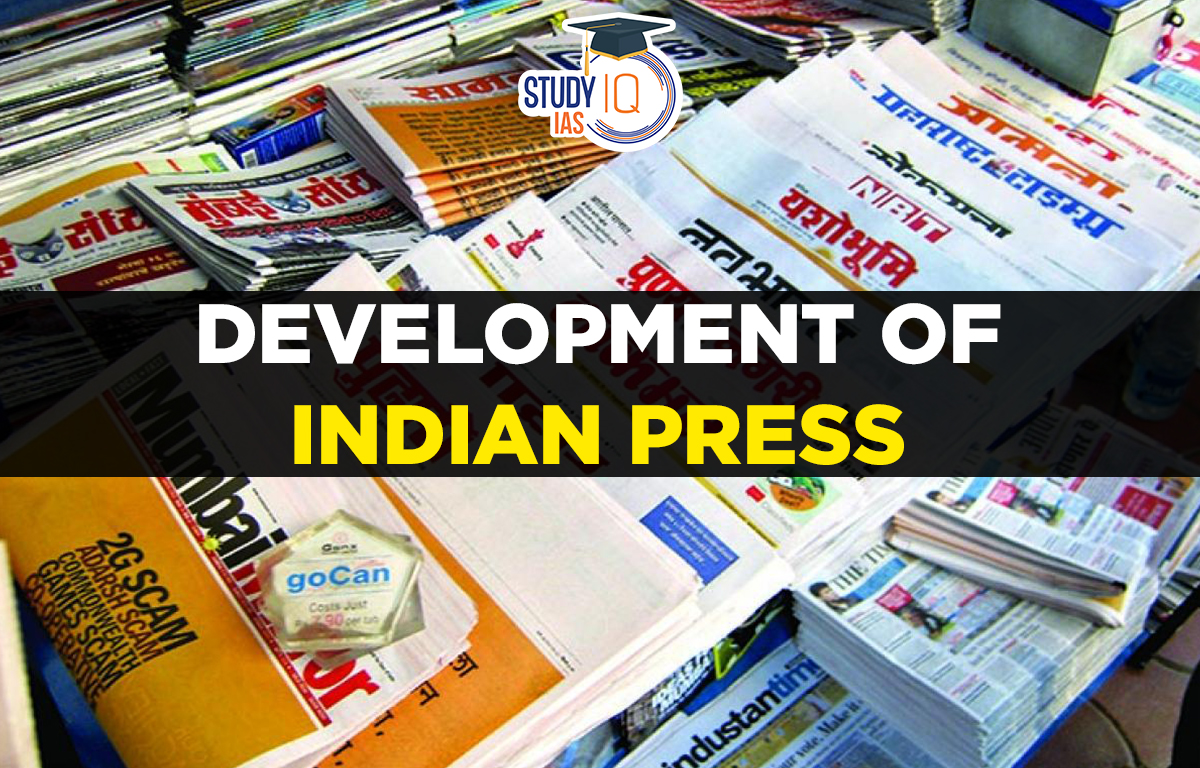Table of Contents
Development of Indian Press
The British are attributed with introducing participatory journalism or an independent press to India during the colonial era. The British government, however, made more of an attempt to control the Indian press in order to stop the spread of nationalistic sentiments through it. Developmental difficulties, illiteracy, colonial restrictions, and repression complicated the growth of the Indian press. It propagated liberation ideologies and emerged as a crucial tool in the fight for independence. This article will cover the evolution of the press and how it relates to preparing for the UPSC exam.
Read about: Lee Commission
Development of Indian Press during British Rule
The “Bengal Gazette or Calcutta General Advertiser,” established in 1780 by James Augustus Hickey, was confiscated in 1872 as a result of its outspoken criticism of the ruling class. Hickey’s initiatives set the foundation for the Indian press. Later, more publications like The Bengal Journal, Calcutta Chronicle, Madras Courier, and Bombay Herald started to emerge. The Company’s executives were worried that these newspapers would get to London and reveal their transgressions. They recognized the necessity of press restraints as a consequence.
Read about: Two Nation Theory
Development of Indian Press Early Regulations
1. Censorship of Press Act, 1799
To stop the French from printing anything critical of the British, Governor-General Richard Wellesley passed the Censorship of Press Act in 1799. All newspapers were now reviewed by the government before publication as a result of this legislation. Later, in 1807, this act was extended to cover all forms of press publications, such as newspapers, magazines, books, and pamphlets. The regulations were loosened when Francis Hastings (1813–1923) assumed office in 1818.
2. Licensing Regulations, 1823
The Licensing Regulation Ordinance was presented by Governor-General John Adams. This law made it illegal to operate a press without a permit. The majority of the newspapers targeted by the prohibition were those published in or edited by Indians. Raja Ram Mohun Roy, who started publishing his Persian newspaper “Mirat-ul-akhbar” in 1822, stopped doing so as a result.
3. Press Act 1835 (Metcalfe Act)
The 1823 Licensing Regulations were abolished by the 1835 Press Act, also referred to as the Metcalfe Act. In India, Metcalfe gained notoriety as the “liberator of the press.” A printer/publisher was required by the act to give a detailed account of the location of a publication and to stop business activities if a declaration of a similar nature was made. As a result of a liberal press strategy, newspapers have grown quickly.
4. Licensing Act, 1857
The Licensing Act of 1857 was passed by Governor General Canning (who would later become Viceroy in 1858) to place stricter limitations on the press following the Revolt of 1857. This law established licensing requirements and granted the government the right to prevent the publishing and distribution of any book, newspaper, or other printed material.
5. Registration Act, 1867
The Registration Act of 1867 replaced the Metcalfe Act of 1835. It was claimed that the legislation placed regulations but not limitations on the press. The print media now needed to include the name of the printer, publisher, and location of release, and a copy needed to be submitted to the government.
6. Vernacular Press Act, 1878
It was put in place to “better manage” the popular press and it successfully repressed and punished seditious writing. The district judge had the authority to require the printer and publisher of any vernacular newspaper to sign a bond with the government promising not to use published material to incite hatred between members of various castes, religions, or races.
Additionally, the printer and publisher might be asked to put up protection that could be taken if the offences recurred. There was no right of appeal to the magistrate’s judgment in a court of law. Documentation from a regional newspaper could be accepted by a government censor to excuse it from the Act’s application.
7. Newspaper (Incitement to Offences) Act, 1908
The Newspaper (Incitement to Offense) Act of 1908 gave judges the authority to seize press assets that published offensive content that might incite homicide or other violent crimes. This act was brought about by extreme nationalist action both during and after the Swadeshi movement of 1906.
8. Indian Press Act, 1910
This act replaced the Vernacular Act, which gave local governments the authority to request a security from publishers or printers upon registration and forfeit or deregister an offending newspaper. Additionally, printers of newspapers were required to provide local governments with two copies of each issue.
Read about: Indian Independence Act 1947
Development of Indian Press UPSC
The Indian press experienced difficulties under British control due to factors like illiteracy, colonial pressure, and repression. Later on, though, it emerged as a crucial weapon in the fight for freedom. Media played a significant role in shaping and increasing national consciousness among Indians. The invention of printing papers led to a large-scale nationalist campaign in India. For all the information regarding the Development of Indian Press for UPSC Exam preparation, read the article.
Read about: Mountbatten Plan


 Nagari Pracharini Sabha Revival: Backgro...
Nagari Pracharini Sabha Revival: Backgro...
 Ryotwari System in India, Features, Impa...
Ryotwari System in India, Features, Impa...
 Battle of Plassey, History, Causes, Impa...
Battle of Plassey, History, Causes, Impa...





















